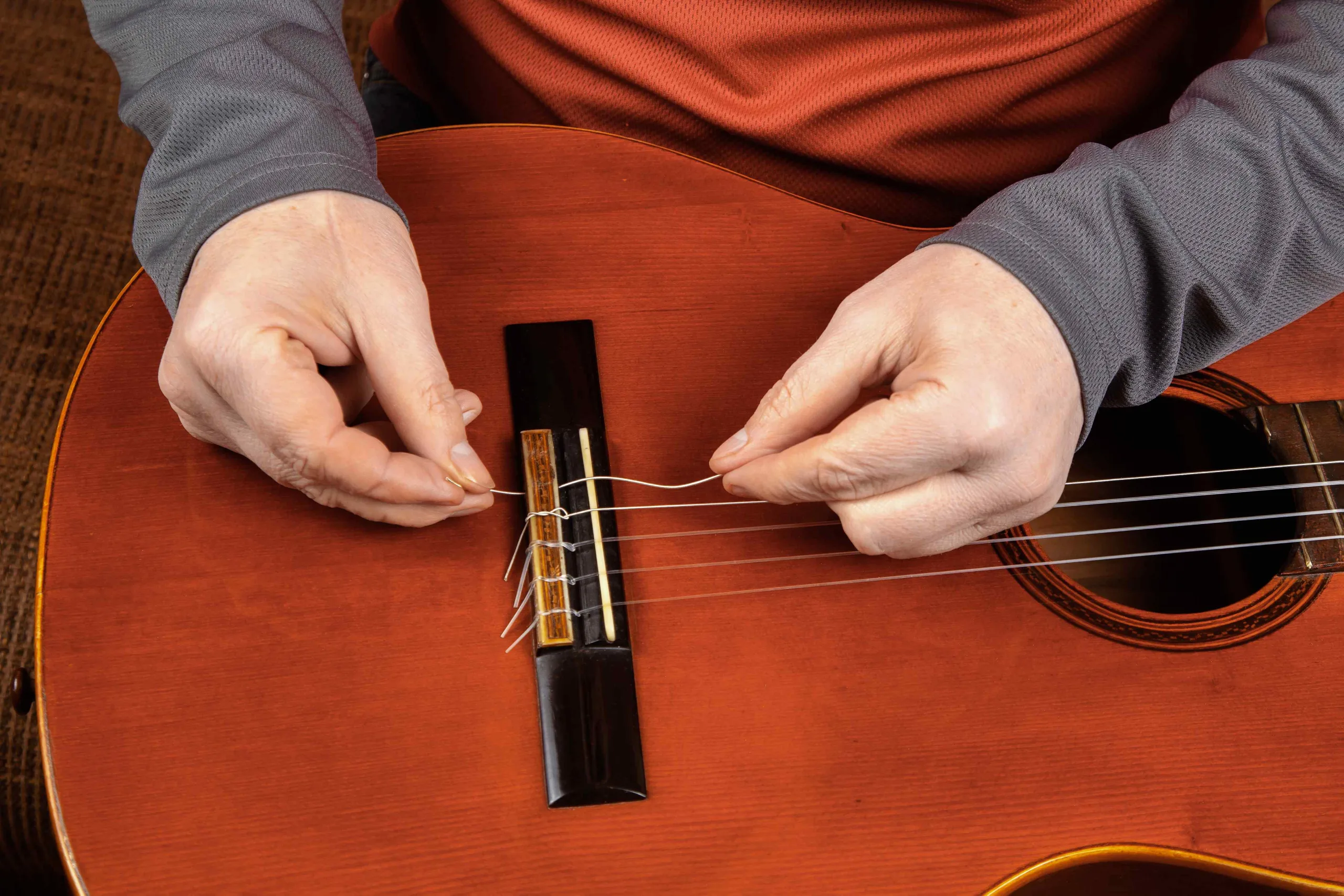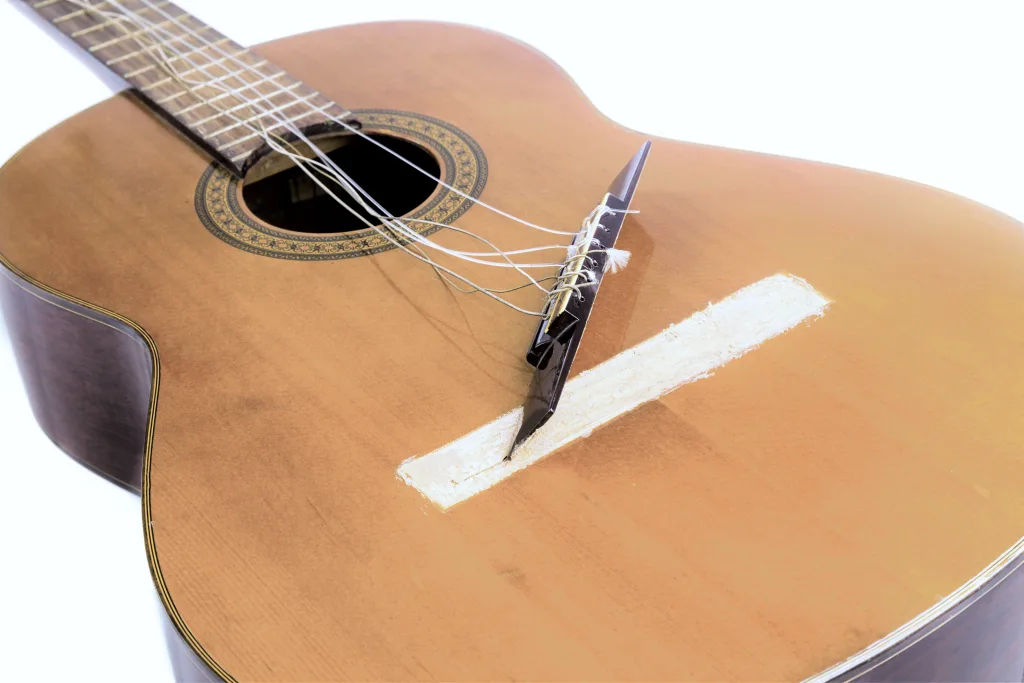If you like to experiment with your strings, you may have wondered how your classical guitar would sound if you put steel strings on it.
Is it possible?
Yes, you can practically put steel strings on a classical guitar.
Is it okay to do it?
Definitely not.
Putting the wrong strings on your guitar can lead to some problems. Not only you’ll not get a perfect sound, but you can seriously damage your guitar.
In this article, we have described all the negative consequences of putting steel strings on a classical guitar.

Why you shouldn’t put steel strings on a classical guitar
You shouldn’t put steel strings on a classical guitar due to the differences between the acoustic and the classical guitars.
Differences in guitar tops and bracings
The differences in guitar tops and bracings are a huge reason you shouldn’t put steel strings on a classical guitar.
Classical guitars are designed to be used with nylon strings and have characteristics that distinguish them from acoustic guitars. They have thinner tops and smaller, flexible braces called (fan bracing).
On the other hand, acoustic guitars are stronger, with thicker tops and heavier, sturdier bracing (X-bracing).
Differences in the string action
The differences in the string action are also a reason to not put steel strings on a classical guitar.
Nylon string guitars typically have higher string action, approximately 3-4 mm. However, Flamenco guitars are an exception, as they have much lower string action.
In contrast, acoustic guitars maintain a 2-2.5 mm string action. While this can vary based on personal preference, the action on steel string guitars is generally lower than a traditional classical guitar.
Differences in the truss rod
The truss rod is a metal beam inside the guitar’s neck that helps balance the tension of the strings. Classical guitars don’t have one because nylon strings produce low pressure. Some new models have a truss rod, which isn’t enough to counterbalance the steel strings.
Differences in the guitar nut
The nut on classical guitars has wider slots because the nylon strings are thicker than steel strings. The nut is also higher than that of an acoustic guitar, which can lead to issues with intonation and make playing difficult.

The risks of using nylon strings on steel guitars
Unstable Tuning
Unstable tuning is usual for nylon strings. Even classical guitars need regular tuning due to the string’s sensitivity.
Soft nylon is vulnerable to changes in humidity and temperature, resulting in more frequent tuning issues compared to steel strings. Steel strings, once adjusted and settled, are generally more stable.
Neck damage due to uneven tension
Uneven neck tension may result from using nylon strings on a steel-string guitar. That can lead to neck damage due to insufficient tension.
Even if a combination of steel and nylon strings, such as three steel and three nylon, creates uneven neck tension.
For proper tuning, steel strings require tighter winding, while nylon strings are relatively loose and flexible.
Quick wear on nylon strings due to incompatibility with guitar picks
Incompatibility with guitar picks can cause quick wear on nylon strings and produce a significantly different sound.
Nylon strings are not designed for strumming with guitar picks, as evidenced by the absence of pickguards on classical guitars. They are primarily intended for fingerpicking, often utilizing long or artificial nails.
Restringing Challenges
Restringing can be a challenge due to the differences in string ends and bridge designs.
Steel-string acoustic guitar strings feature ball-ends inserted into the bridge and secured with pegs. In contrast, nylon string guitars have plain ends that are tied to the bridge using knots.
This fundamental difference makes it impossible to restring an acoustic guitar designed for steel strings with nylon strings, as classical guitars have specific bridge designs to accommodate nylon strings.

Conclusion
We highly recommend you not to use steel strings on your classical guitar.
Doing the opposite and putting nylon strings on an acoustic guitar is also not recommended. Make sure to check this article before doing so.
The delicate nature of classical guitars, designed specifically for nylon strings, makes them unsuitable for the higher tension and different characteristics of steel strings.
Attempting to use steel strings on a classical guitar can result in damage to the instrument, including warping or cracking.
It’s essential to respect the intended design and limitations of your guitar to ensure optimal performance and longevity. Stick to nylon strings for classical guitars and explore other guitar types if you prefer the sound and playability of steel strings.
FAQ
Do steel strings hurt more?
Yes, steel strings will hurt your fingers more than nylon strings. They are made of steel, after all. Not only that, but we have to exert more force when we play because they are under more tension.
Do steel strings rust?
Yes, steel strings rust because there is iron content in them. How quickly rust will appear depends on the moisture levels in the air.
We advise storing your guitar correctly, cleaning the strings after playing, and using high-quality strings with more rust resistance.

